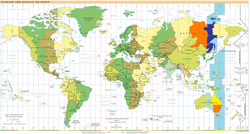
The Chamorro Time Zone, [1] formerly the Guam Time Zone, is a United States time zone which observes standard time ten hours ahead of Coordinated Universal Time (UTC+10:00). The clock time in this zone is based on the mean solar time of the 150th meridian east of the Greenwich Observatory.
Contents
The zone includes the U.S. territories of Guam and the Northern Mariana Islands, where the Chamorro people are the original inhabitants. Since Daylight Saving Time (DST) is not observed anywhere in this zone, the time is always known as Chamorro Standard Time (ChST).
The zone is two hours behind Wake Island Time Zone and 15 hours ahead of North American Eastern Time Zone. As of March 19, 2024 it is the easternmost (farthest ahead) time zone shown on the U.S. government's time.gov webpage. Although Wake, Howland and Baker Islands are U.S. territories in more easterly time zones (that are not shown), they are uninhabited.
Chamorro Standard Time shares the same time as Australian Eastern Standard Time. The State of Queensland also does not observe DST, so the Commonwealth of the Northern Mariana Islands (CNMI), Guam and Queensland are on the same time year round.